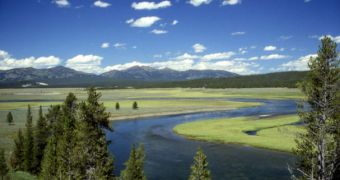Back in the days when our planet was very young, the continents and oceans did not resemble anything we know and see today. The outer layer of the planet, the crust, was in a constant process of rearrangement, and volcanic eruptions were a common thing. But, from time to time, crust explosions at a grand scale took place, when supervolcanoes blew up, and spewed unimaginably large amounts of lava and ash into the atmosphere and on the ground. Now, such a fossil structure has been discovered in the Italian Alps, a discovery that could hold the key to understanding active supervolcanoes, such as the Yellowstone Caldera, ScienceDaily reports.
In the past, supervolcano eruptions are thought to have caused wide-scale changes in the planet's environment, and are believed to have also influenced its climate considerably. An eruption throwing out sufficient amounts of ash, for instance, could block out the Sun, and bring forth a period of glaciation almost over night. Such changes would have left species unable to adapt, and those who could not flee fast enough were killed or wiped out. However, such devastating effects were presumably fairly rare, as huge amounts of pressure would have had to form beforehand.
The experts who discovered the remains of such a structure, in the Sesia Valley, say that it could hold the key to a better understanding of how these volcanoes worked. These studies are of paramount importance for assessing the threat level of existing supervolcanoes, such as Yellowstone, which last erupted about 630,000 years ago, and could blow up in a short while. The Italian site is invaluable because it offers scientists a clear view well inside the intricate workings of a volcano, from the crater to the magma chamber underground.
“What's new is to see the magmatic plumbing system all the way through the Earth's crust. Now we want to start to use this discovery. We want to understand the fundamental processes that influence eruptions: Where are magmas stored prior to these giant eruptions? From what depth do the eruptions emanate?” the US Geological Survey (USGS) Volcano Hazards Program Program Coordinator, James E. Quick, says. He now works as a geology professor at the Southern Methodist University.
Studies “might lead to a better interpretation of monitoring data and improved prediction of eruptions,” he adds. Quick is also the lead author of an article reporting the discovery, entitled “Magmatic plumbing of a large Permian caldera exposed to a depth of 25 kilometers.” The work appears in the July issue of the peer-reviewed journal Geology.
“We think of the Sesia Valley find as the 'Rosetta Stone' for supervolcanoes because the depth to which rocks are exposed will help us to link the geologic and geophysical data. This is a very rare spot. The base of the Earth's crust is turned up on edge. It was created when Africa and Europe began colliding about 30 million years ago and the crust of Italy was turned on end,” Quick concludes.

 14 DAY TRIAL //
14 DAY TRIAL //